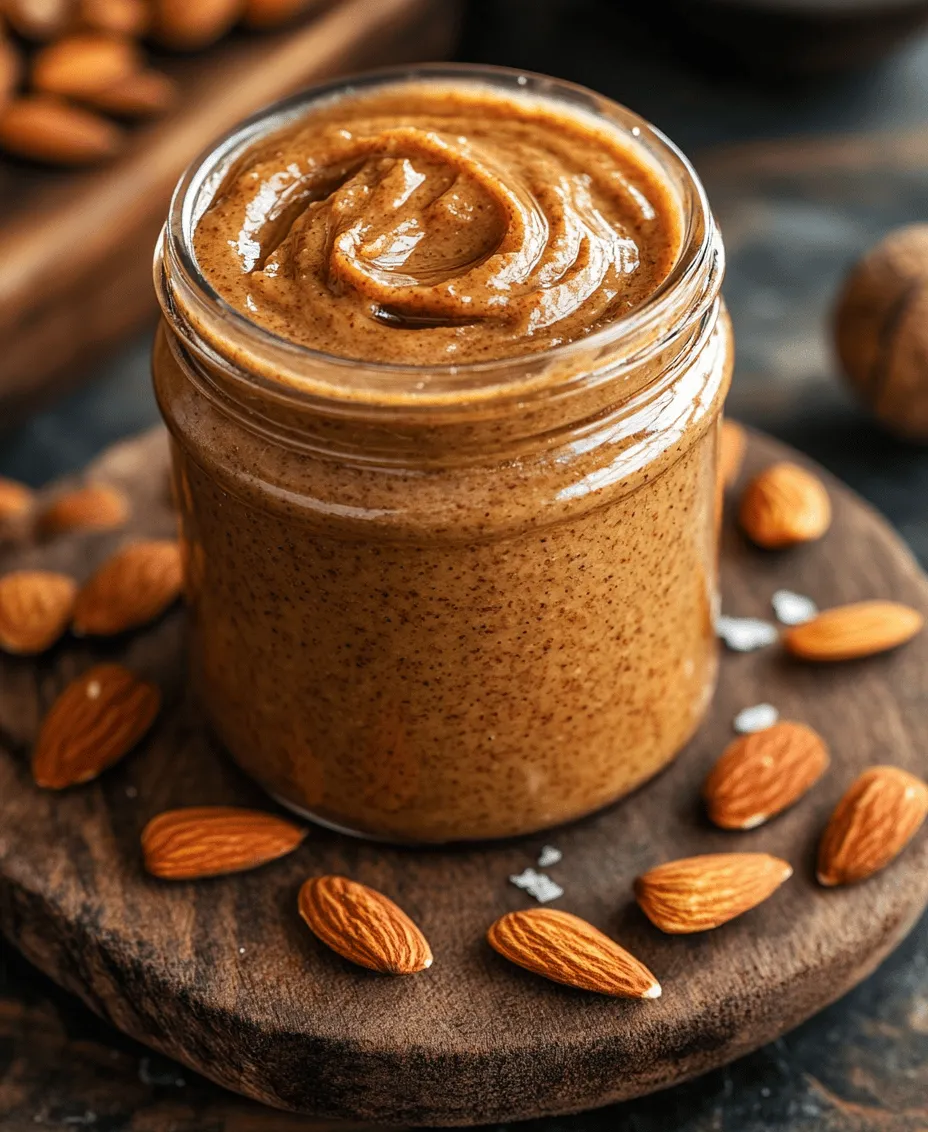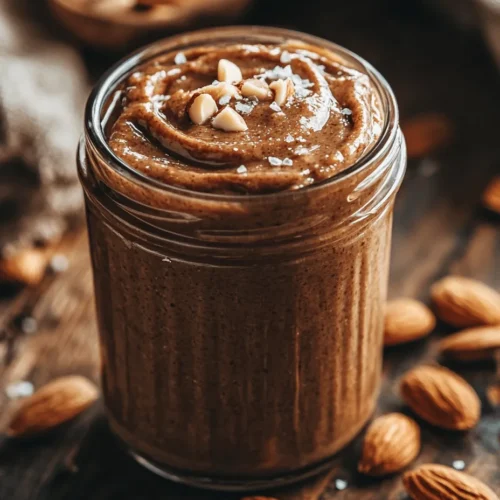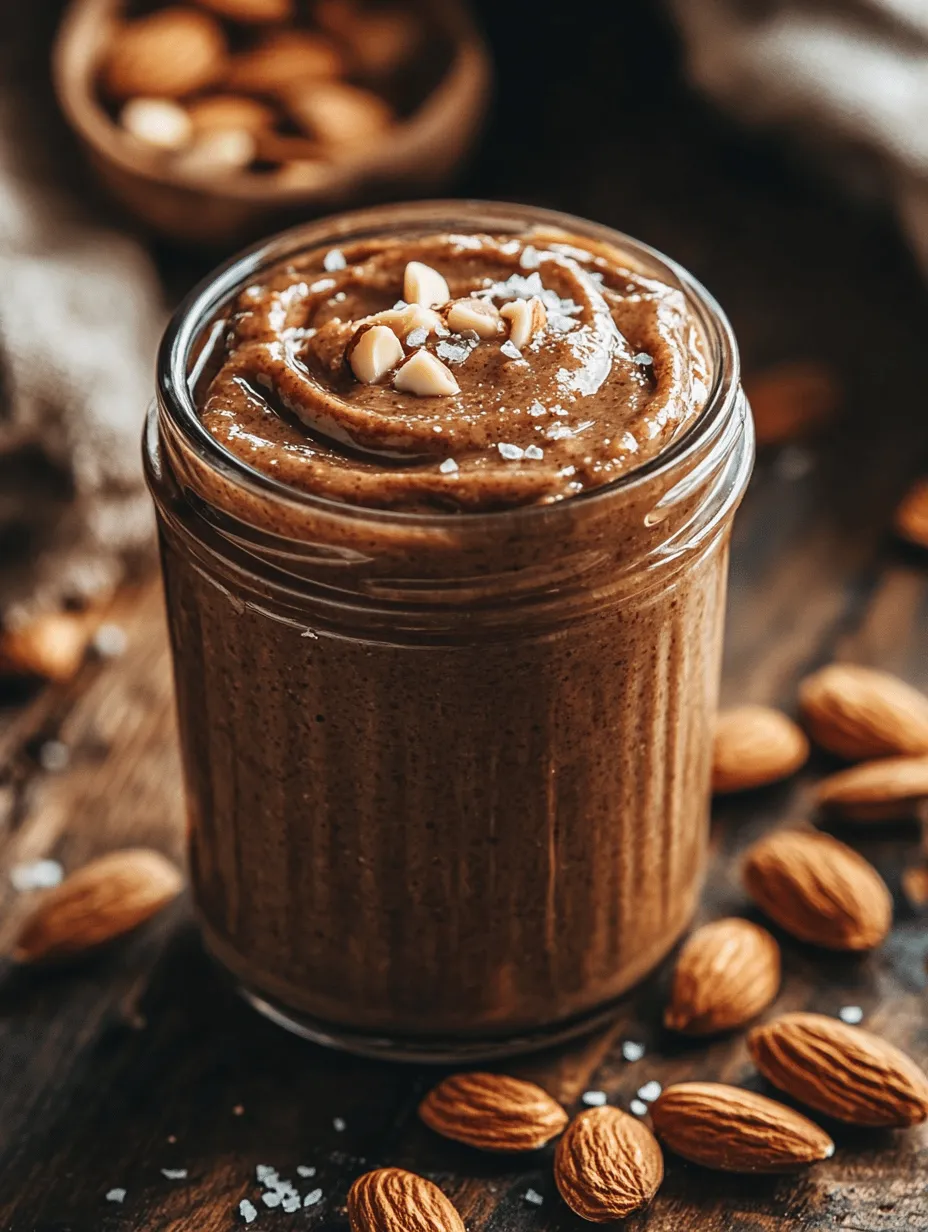Introduction to Homemade Almond Butter
In the world of nut butters, almond butter stands out for its creamy texture, rich flavor, and numerous health benefits. Making your own almond butter at home not only allows you to control the ingredients but also provides a fresher taste compared to store-bought versions. Whether you’re slathering it on toast, adding it to smoothies, or using it in baking, homemade almond butter is a versatile and delicious option for any meal or snack.
This article will guide you through the process of creating “Nutty Bliss: Homemade Almond Butter.” This recipe is simple, customizable, and can be tailored to fit your personal preferences. The ease of preparation, along with the ability to choose your ingredients, makes homemade almond butter an attractive option for health-conscious food lovers. Let’s dive into the delightful world of homemade almond butter!
Understanding the Benefits of Almond Butter
Exploring Nutritional Value
Almond butter boasts a wealth of nutritional benefits that make it an excellent addition to your diet. Raw almonds, the primary ingredient in almond butter, are packed with essential nutrients. They are rich in healthy monounsaturated fats, protein, fiber, vitamins, and minerals. A single serving of almond butter typically contains:
– Protein: Essential for muscle repair and growth.
– Fiber: Promotes digestive health and helps maintain a feeling of fullness.
– Healthy Fats: Supports heart health and can aid in weight management.
– Vitamin E: Acts as a powerful antioxidant, protecting your cells from oxidative damage.
– Magnesium: Vital for numerous biochemical reactions in the body, including energy production and muscle function.
When compared to other nut butters, almond butter often comes out on top in terms of nutrition. While peanut butter is also popular, almond butter contains more vitamin E and magnesium and is lower in saturated fat. This makes almond butter a superior choice for those looking to maximize their nutrient intake.
Health Benefits Associated with Almond Consumption
Research has shown that incorporating almonds into your diet can have a variety of health benefits. Here are some of the notable advantages:
– Heart Health: Regular consumption of almonds has been linked to improved heart health, thanks to their ability to lower bad cholesterol levels and reduce inflammation.
– Weight Management: The combination of protein, fiber, and healthy fats in almond butter can help control appetite, making it easier to maintain a healthy weight.
– Blood Sugar Control: Almonds have a low glycemic index and can help stabilize blood sugar levels, making almond butter a suitable choice for those with diabetes or insulin resistance.
– Bone Health: Almonds are a good source of calcium and magnesium, both of which are essential for maintaining strong bones.
These benefits, combined with the delightful taste of almond butter, make it a worthwhile addition to your diet.
The Advantages of Making Almond Butter at Home
Cost-Effectiveness of Homemade Almond Butter
One of the primary advantages of making almond butter at home is its cost-effectiveness. Store-bought almond butter can be quite pricey, especially for high-quality brands. By purchasing raw almonds in bulk and transforming them into almond butter, you can significantly reduce your overall costs. Plus, making your own allows you to make larger batches, ensuring you always have a delicious spread on hand.
Control Over Sweetness and Additives
Another significant benefit of homemade almond butter is the control it gives you over the ingredients. Commercial nut butters often contain added sugars, oils, and preservatives that can detract from the health benefits of the product. By making your own, you can choose to keep it as simple or as indulgent as you like. Whether you prefer your almond butter unsweetened, lightly sweetened with honey or maple syrup, or flavored with spices, the choice is entirely yours.
Freshness and Flavor Enhancement
The freshness of homemade almond butter is unparalleled. When you prepare almond butter at home, you can enjoy it at its peak flavor. Store-bought versions may sit on shelves for weeks or even months, losing some of their vibrant taste and nutritional value. Making almond butter fresh means you can enjoy a nutty, rich flavor that enhances your dishes and snacks.
Ingredients for Nutty Bliss Almond Butter
Essential Ingredients Breakdown
To create your own Nutty Bliss Almond Butter, you will need just a few essential ingredients. Understanding the role of each ingredient will help you create a product that meets your expectations.
– Raw Almonds: The star ingredient of this recipe. It’s crucial to select high-quality raw almonds, preferably organic, to ensure you’re getting the best flavor and nutritional benefits. The type of almond you choose can also impact the final texture and taste of your almond butter, so opt for whole, fresh almonds without any additives.
– Sweeteners: While almond butter is delicious on its own, you might want to add a touch of sweetness. Honey and maple syrup are popular choices, but each brings a unique flavor profile. Honey tends to be sweeter and has a thicker consistency, while maple syrup offers a more subtle sweetness with a hint of earthiness. You can choose one based on your taste preferences or dietary needs.
– Salt: A pinch of salt can enhance the overall flavor of your almond butter. It helps balance the sweetness and brings out the nutty notes of the almonds. However, be mindful of the amount you add, especially if you’re watching your sodium intake.
– Coconut Oil: This ingredient is optional but highly recommended for achieving a creamy texture. Coconut oil adds smoothness to the almond butter and can help prevent it from becoming too thick during blending. Additionally, it brings a subtle tropical flavor that complements the almonds beautifully.
Optional Ingredients and Variations
To personalize your almond butter even further, consider adding some optional ingredients or variations:
– Flavor Enhancements: You can infuse your almond butter with various spices or other nuts to create unique flavor profiles. For instance, adding cinnamon or vanilla extract can provide a warm, comforting taste, while a splash of cocoa powder can transform it into a decadent chocolate almond butter. You could also experiment with adding other nuts like cashews or hazelnuts for a more complex flavor.
– Dietary Adjustments for Vegan or Sugar-Free Options: If you’re following a vegan diet or prefer a sugar-free option, you can easily adapt the recipe. Use agave syrup or stevia as a sweetener instead of honey or maple syrup. This will allow you to enjoy a delicious nut butter that aligns with your dietary preferences.
Step-by-Step Guide to Making Almond Butter
Prepping Your Almonds
Now that you’re familiar with the ingredients and their benefits, it’s time to start the process of making your Nutty Bliss Almond Butter. The first step involves prepping your almonds.
1. Choosing Your Almonds: Select high-quality raw almonds. If you have a preference for roasted almonds, you can use those as well; however, raw almonds will yield a smoother texture.
2. Roasting (Optional): If you prefer a more intense flavor, consider roasting your almonds beforehand. Spread them evenly on a baking sheet and roast in the oven at 350°F (175°C) for about 10-12 minutes. Keep a close eye on them, as nuts can burn quickly. Roasting enhances the nuttiness and can result in a richer almond butter.
3. Cooling: Allow the roasted almonds to cool before blending. This step is essential as hot almonds can cause the nut butter to heat up too quickly during processing, affecting the consistency.
4. Blending: Once cooled, it’s time to blend your almonds. Place them in a high-powered food processor or blender. Start blending on a low setting to break down the almonds into small pieces. Gradually increase the speed as the almonds begin to release their oils.
As you blend, you will notice the almonds transitioning from a crumbly texture to a paste-like consistency, and finally to a smooth almond butter. Be patient, as this process can take several minutes. If the mixture seems too thick or is sticking to the sides of the processor, pause to scrape down the sides and help the blending process along.
Stay tuned for the next section where we will cover additional steps and tips to perfect your homemade almond butter!

The Importance of Roasting Almonds: Enhancing Flavor and Texture
Roasting almonds is a crucial step that significantly enhances the flavor and texture of your homemade almond butter. Raw almonds have a mild taste, but roasting brings out their natural oils and nutty flavors, creating a richer, more robust profile that elevates your almond butter to new heights. The roasting process also contributes to a creamier texture, making it easier to blend into a smooth, velvety spread.
Recommended Roasting Time and Temperature
To achieve the best results, preheat your oven to 350°F (175°C). Spread the raw almonds in a single layer on a baking sheet. Roast them in the oven for approximately 10-12 minutes, stirring halfway through for even roasting. Keep a close eye on them to prevent burning, as nuts can go from perfectly toasted to charred in just a minute. Once they’re fragrant and slightly darker in color, take them out and allow them to cool for a few minutes before blending.
Blending Techniques for Perfect Consistency
Achieving the perfect consistency for your almond butter requires the right technique and equipment. Whether you’re using a high-powered blender or a food processor, understanding how to properly blend your almonds is key to creating that smooth, creamy texture.
How to Use a Blender or Food Processor Effectively
If you’re using a blender, it’s best to use one designed for nut butters, as these are often more powerful and better suited for the job. Start by adding your roasted almonds to the blender or food processor. Pulse the almonds a few times to break them down, then turn the machine on to a medium speed. Scrape down the sides as needed to ensure all almonds are evenly processed.
For food processors, the same principles apply. Begin with short pulses to break down the nuts, then continue blending at a steady speed. If you notice the mixture becoming too thick, stop and scrape down the sides to incorporate all the almond bits.
Tips for Achieving the Right Creaminess
The process of blending almonds into butter can take several minutes, so patience is essential. Initially, you’ll see almond meal forming, and then it will start clumping together. Continue blending until the oils release and the mixture transforms into a smooth butter. This process typically takes about 10-15 minutes, depending on your machine’s power.
If you prefer a thinner almond butter, you can add a small amount of neutral oil, such as grapeseed or coconut oil. Start with a teaspoon, blending it in until you reach your desired consistency.
Understanding the Blending Process: From Meal to Butter
The transformation of almonds from meal to butter involves a lot of friction, which generates heat and allows the natural oils to flow. As you blend, the nuts will first break down into a coarse meal, then a thick paste, and finally achieve a smooth and creamy consistency. Be attentive during this process, and don’t hesitate to stop and scrape down the bowl as necessary to ensure uniform texture.
Adding Sweetness and Flavor
Once your almond butter reaches the desired creaminess, it’s time to add sweetness and flavor to elevate your creation.
When and How to Incorporate Sweeteners and Salt
You can add sweeteners at any time during the blending process. If you prefer a natural sweetener, consider using honey, maple syrup, or agave nectar. Start with a small amount—about a tablespoon—and blend it in, tasting as you go to find your preferred level of sweetness.
Salt is another important addition that can enhance the overall flavor. A pinch of sea salt can balance the sweetness and highlight the nutty taste of the almonds. As with sweeteners, add salt gradually and taste until you achieve the perfect balance.
Adjusting Flavors to Suit Your Taste Preferences
Feel free to experiment with flavorings to make your almond butter uniquely yours. Vanilla extract, cinnamon, or cocoa powder can add delightful notes to your almond butter. Start with small amounts, blending well and tasting along the way until you find the perfect flavor combination that suits your palate.
Storing Your Almond Butter
Storing your homemade almond butter properly is essential to maintaining its freshness and flavor.
Best Practices for Transferring and Storing Almond Butter
Once your almond butter is blended to perfection, transfer it to a clean, airtight jar. Glass jars work best as they are non-reactive and can help preserve the flavors. Make sure the jar is completely dry, as moisture can lead to spoilage.
Shelf Life and Refrigeration Tips
Homemade almond butter can be stored at room temperature for about a week if kept in a cool, dark place. However, for longer shelf life, it’s best to refrigerate your almond butter, where it can last for up to a month. If you notice any changes in color or smell, it’s best to discard it to ensure food safety.
Creative Ways to Use Almond Butter
Almond butter is not just a delicious spread; it’s a versatile ingredient that can enhance various dishes and snacks. Here are some creative ways to incorporate almond butter into your meals.
Delicious Recipes Featuring Almond Butter
Smoothies and Shakes: Boosting Nutrition and Flavor
Almond butter makes a fantastic addition to smoothies and shakes. Blending a tablespoon of almond butter into your favorite smoothie not only adds creaminess but also boosts the nutritional profile with healthy fats and protein. Try mixing it with banana, spinach, and almond milk for a nutritious breakfast on the go.
Spreads and Dips: Enhancing Your Favorite Snacks
Use almond butter as a spread on whole grain toast or as a dip for apple slices, celery sticks, or crackers. You can also create a delicious dip by mixing almond butter with Greek yogurt, honey, and a sprinkle of cinnamon, making it perfect for fruit or veggie platters.
Baking with Almond Butter: Healthy Alternatives in Desserts
Almond butter can be a fantastic substitute for butter or oil in baking recipes, providing a nutty flavor and moist texture. Use it in cookie recipes, brownies, or energy balls for a healthier twist. The nutty flavor pairs wonderfully with chocolate or oats, creating a delicious treat that’s both satisfying and nutritious.
Incorporating Almond Butter into Your Daily Diet
Breakfast Ideas: Oatmeal, Toast, and More
Start your day with almond butter by spreading it on whole-grain toast topped with sliced bananas and a drizzle of honey. Alternatively, stir a tablespoon into your oatmeal or yogurt for added creaminess and flavor, delivering a nutritious breakfast that will keep you full longer.
Health-Conscious Snacking Options
Almond butter is an excellent snack option that can curb cravings and provide sustained energy. Pair it with rice cakes, whole-grain crackers, or simply enjoy it by the spoonful for a quick and satisfying treat. You can also mix it with a small amount of dark chocolate for a healthier indulgence.
Meal Prep Ideas That Include Almond Butter
Incorporating almond butter into your meal prep can be both easy and delicious. Think about preparing almond butter-based salad dressings by combining it with vinegar, olive oil, and spices. You can also make almond butter energy bars or bites to have on hand for quick snacks throughout the week.
Conclusion: The Joy of Homemade Almond Butter
Creating Nutty Bliss: Homemade Almond Butter is not only a rewarding culinary experience but also a way to enjoy a nutritious and versatile food that fits seamlessly into various diets. With simple ingredients and straightforward steps, you can elevate your meals and snacks while reaping the health benefits of almonds. Embrace the joy of homemade almond butter, and let your creativity flow in the kitchen! Whether you’re using it in smoothies, as a spread, or in baking, almond butter adds a delicious and healthy touch to your everyday meals. Enjoy the process, and savor the delightful flavors of your homemade creation!


